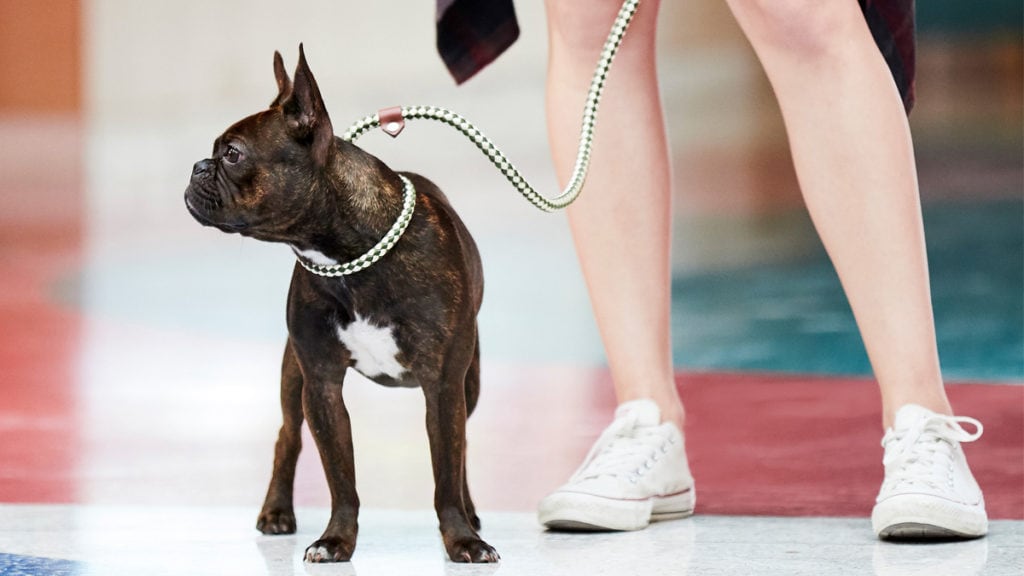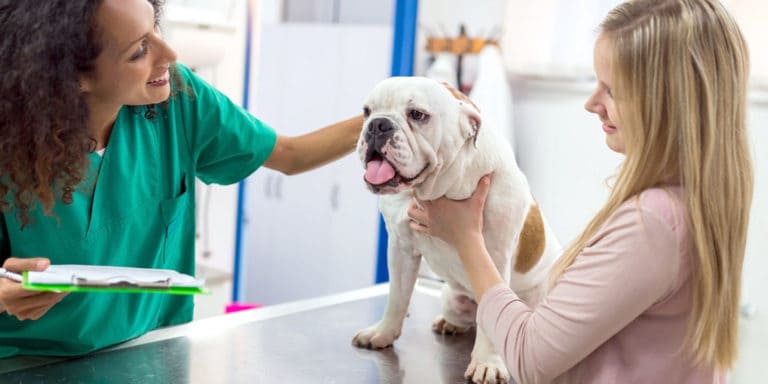Contributed by Russell Hartstein, certified dog/cat behaviorist and trainer and CEO (Canine Executive Officer) of Fun Paw Care in Los Angeles, California.
When you’re out for a walk with your dog and see someone on a skateboard across the street, does your dog perk up and begin growling? If a bicycle is approaching, does your pup lunge in attack mode? Have you ever been outside walking your dog and when a car approaches he begins to bark and chase after it?
These scenarios are far too common. I often am asked, “Why is my dog so leash-reactive?” Before we delve into how to modify leash aggression, we must cover some basics and understand why this behavior occurs in the first place. Which, most of the time, boils down to understanding why dogs are fearful.
Why Are Dogs Fearful?
Dogs get scared easily if they are not appropriately socialized to new people, places and things. Dogs enjoy novel things, so exposing them to new environments, sounds, smells, sites, tactile surfaces and tastes provide your pup with enriching experiences. These positive socialization experiences will help to make him more resilient to these stimuli in the future.
However, when a dog isn’t properly socialized, walks can actually cause him stress and he can become reactive to new stimuli. To understand why a dog may exhibit fear while on a walk, it helps to understand the psychological development process your dog goes through during his puppy years.
Significance of a Puppy’s Sensitive Period
Novelty becomes frightening and stressful when dogs are not socialized at a very young age. The development of a dog’s social and cognitive behavior is primarily during what is referred to as their “sensitive/critical period.” This sensitive period occurs when a dog is roughly 3 to 13 weeks of age.
During this period, a dog is the most receptive and open to learning and exploring his environment with the least amount of fear and the most amount of curiosity. This sensitive period is very important, because a dog learns more about the world at this time than at any other time in his life. Natural curiosity will guide his way as his sensory, motor, social and learning faculties are developing. However, if a dog has had an unpleasant (fearful) experience during this period, the dog will be timid, shy and fearful.
How Fear Turns Into Reactivity
When a puppy’s shyness is left untreated, it will likely develop into fear, or in more severe cases, into a phobia. Dogs become reactive to novel life events when they are fearful.
A reactive dog will start to display behaviors like lunging at other dogs while on a leash or barking at unfamiliar people, places and things. Reactivity and inappropriate behavior become the norm, not the exception.
Leash reactivity is common in dogs and is seen in more than 50 percent of dogs on leash. When a fearful dog is on a leash, his communication and full body expression are limited. He is incapable of putting distance between himself and any potential scary stimuli. When this occurs, a dog will often resort to reacting: lunging, growling, snapping—all of which are typically described as aggressive behaviors.
To modify behaviors, a trainer will identify the triggers and help the dog find healthier ways for coping with stressful stimuli.
How to Reduce Reactive Behaviors in Your Dog
Fear does not merely go away on its own by exposing a dog randomly to environments or stimuli that frighten him. If you force a reactive dog to be exposed to a stimulus that the dog is scared of, the dog’s fear will most likely escalate and the dog will become sensitized, not desensitized, to the stimulus—the opposite of what is needed.
When dealing with a fearful dog, it’s best to consult an experienced, professional trainer or behaviorist. The professional you choose starts by gathering as much information as possible on your dog, including medical history, the development and growth of the dog, emotional states, training history, environmental factors, family information, exercise, diet, nutrition, enrichment and socialization history and routines. Once the trainer or behaviorist has a good sense of your dog’s developmental experiences, they will set up a behavior-modification protocol.
This protocol involves the stimuli that triggers your dog’s behavior, your dog’s behavior and the consequence of the behavior. In the protocol, the trainer will move the dog far enough away from the stimuli so that your dog feels safe and no longer threatened by the offending stimuli. The trainer may also take your dog completely out of the environment.
Once your dog feels safe in his environment, the trainer will begin teaching your dog foundational behaviors. Foundation behaviors will look like basic confidence-building dog training (like sit, down and stay). After many repetitions of these behaviors where no fear is exhibited, we begin to practice generalizing these behaviors in many environments without the fear-inducing stimulus present.
After your dog becomes comfortable with performing these tasks, you can begin to gradually and methodically introduce him to the stimuli that are scary to him.
At this point, a systematic desensitizing and counterconditioning (D/CC) behavior modification protocol will be put into place. This methodical rehearsal should be planned out with a professional very carefully and thoroughly.
Some of the most common mistakes are rushing your dog by pushing them too far too fast, or some aspect of the protocol is not set up properly or executed correctly. This will cause your dog to become sensitized instead of desensitized to the stimuli and make them even more reactive and the problem behavior more serious. In more severe cases, it can cause the formation of a conditioned emotional response (CER). It is wise to consult a professional behaviorist with extensive experience when working with reactive dogs, fears, anxieties, phobias and behavior modification.
Additional Takeaways
- Always set your fearful dog up for success.
- Use proper equipment such as muzzles, front attaching harnesses, martingale collars or head halters.
- Use positive and humane training techniques to encourage confidence-building.
- Merely exposing a dog to scary stimuli does not typically cure or help their fear. Most of the time it sensitizes him to it and increases the dog’s
- Hire a professional to set up a structured behavior modification plan, practice desensitizing and counterconditioning (D/CC) to implement systematically and successfully.
- Consider anti-anxiety medications or supplements if phobias exist and other remedies don’t work. Be mindful that these medications or supplements work best when used in conjunction with a behavior modification plan.
Share:












